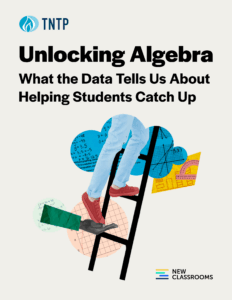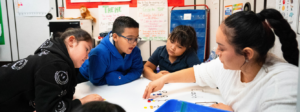When I was a child, school was difficult because English was not my first language and there were not many supports or resources for multilingual learners. I didn’t have teachers who looked like me or understood what it was like to be a multilingual learner. I often felt alone in the classroom because I was unsure of the language and lacked that feeling of belonging.
I remember I loved math because we focused on computation and the language demands were less overwhelming. I also had the freedom to compute in my home language and the only barrier was explaining my thinking in English. I decided to become a math educator to remove the barriers I faced as a student, advocate for multilingual learners, and empower them in my classroom and school.
I wanted to become the teacher that I wish I had.
That mindset has guided my career as an educator. Too often students are held to low expectations, denied access to rigorous mathematical tasks, and are not challenged to truly push themselves. I know from my own experience that when students are provided access to grade-level content, high-quality culturally relevant tasks, and effective teaching practices that center their strengths and honors their thinking strategies, they can and will succeed.
After hearing Dr. Miguel Cardona, former Connecticut Commissioner of Education and now Secretary of Education, recommended TNTP’s landmark report, The Opportunity Myth. I wanted to learn more. I came across TNTP’s resources on learning acceleration, and was able to connect with Mary Pittman, a director at TNTP, and collaborators from Zearn, to host an event through NCSM: Leadership in Mathematics Education.
The resources from TNTP were thoughtful, well-organized, and practical for educators. After working for more than two decades in schools, I had seen over and over that focusing solely on remediation simply didn’t work. “Meeting students where they are,” while perhaps intuitive, doesn’t help them catch up. We need to be giving all students access to grade-level content each year and providing “just-in-time” support when necessary.
That was particularly clear at Greene-Hills School in Bristol, Connecticut where I started as a math coach and later became Dean of Students. The school was one of the lowest performing in the district and had been for some time. I knew that as a team of practitioners, we could change our practices to support ALL our children. There was a team of math interventionists who were working hard, but it wasn’t making a difference for children. In fact, after doing an analysis with the math supervisor, we found students who participated in middle school math intervention programs did worse. The lack of exposure to grade-level content, combined with the high number of students identified for intervention, made it next to impossible to make significant growth. More importantly, students’ math identities had been deeply affected because they knew they were behind.
I wanted to change the narrative of the school. I started bringing information about learning acceleration to our math leadership team. While some members were a bit skeptical, they were willing to try. We read the TNTP report Accelerate, Don’t Remediate and followed up with a shared book study for teachers to discuss research on math instruction, including learning acceleration. This helped them to better understand the concept and showed that acceleration was the right approach because the evidence said so—not because I did.
To start, we revamped our beliefs and delivery for math intervention. Instead of the interventionists operating independently, they joined grade-level math planning meetings. The teachers and intervention team looked at student work and common formative assessments (CFA) results and created flexible groups focused on student misconceptions. We held Reaction Days—each day after a CFA was given, the interventionists analyzed the student work with the teacher and special education teacher and aligned approaches for re-teaching. We took the math interventionists and coaches off all morning duties; instead, they helped at early morning math groups. We were not sure if students would come, but not only did they come, they loved the time.
Next, we modified the classroom and intervention periods to a “vertical classroom” model. In this approach students primarily do math while writing on vertical, non-permanent surfaces like whiteboards—hence the name—instead of sitting at their desks with notebooks. This produced more risk-taking, deeper engagement, and more opportunities for students to collaborate, discuss, and even directly teach one another. That was a significant change for both our math classrooms and intervention blocks. In a short time, students started soaring because they could see the mathematics teachers and interventionists were all working together to ensure they were learning.
In addition to the intervention support and intentional teaching practices, we emphasized collaboration among teachers. Using the book study mentioned above, we held monthly meetings with teacher leaders from grades K-8 to share best practices and talk through challenges. As a result, teachers started inviting one another into their classrooms to observe, which led to even faster growth.
It was amazing how quickly students’ identities started to change. Before these methods, some of the students felt behind and out of touch, but when they were successful, we saw their confidence increase. In some classes, we even gave students the opportunity to be math coaches. The teachers’ beliefs and actions changed, too—once they saw how students were growing, they were excited to keep pushing with learning acceleration.
The work of the Greene-Hills mathematics leadership team, teachers, and students resulted in dramatic progress—spring 2022 test scores exceeded pre-pandemic levels and student gains were higher than the state average. I feel that all educators have a moral imperative to get out of their comfort zones, shift instructional practices, and use an asset-based approach to ensure every learner reaches the highest level of achievement.








